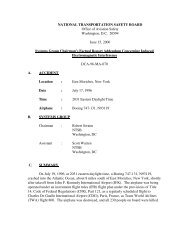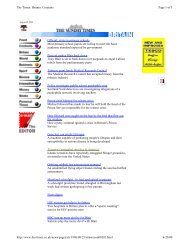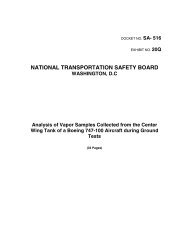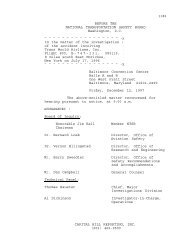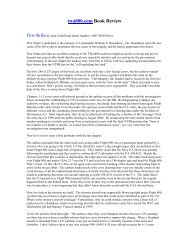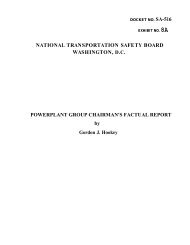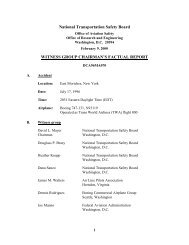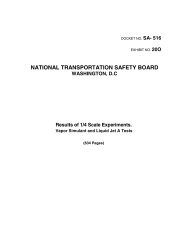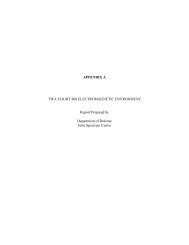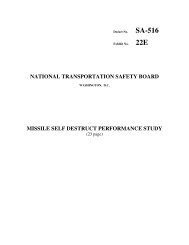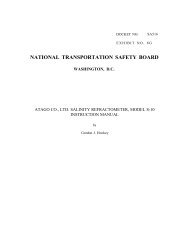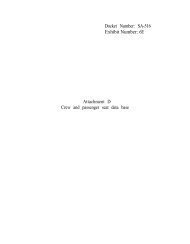Exhibit No. 11A - Group Chairman Factual Report - TWA Flight 800 ...
Exhibit No. 11A - Group Chairman Factual Report - TWA Flight 800 ...
Exhibit No. 11A - Group Chairman Factual Report - TWA Flight 800 ...
You also want an ePaper? Increase the reach of your titles
YUMPU automatically turns print PDFs into web optimized ePapers that Google loves.
<strong>TWA</strong> records indicate that when the aircraft left the <strong>TWA</strong> facility on 12/15/75, the aircraft total timewas 14556:44 hours and 3,250 landings. The modifications that were to be performed while the aircraftwas at the Boeing Company were not accomplished. The maintenance records indicate that no write-ups,modifications or maintenance tasks were performed while the airplane was in Wichita Kansas. Irannever took delivery of the airplane and it was returned to <strong>TWA</strong>’s certificate on December 16, 1976. Theairplane was returned with a total aircraft time of 14563:47 hours and 3,254 landings. Approximatelyseven hours of flight time had been accumulated on the aircraft during this period.After the aircraft was ferried back to the <strong>TWA</strong> facility, the maintenance records indicate that theaircraft was inspected for Airworthiness Directive compliance to return it to an airworthy condition priorto commercial transport service. The commercial passenger services, <strong>TWA</strong> logos, paint, interior cabinmaterials etc. were reinstalled prior to the aircraft returning to commercial service.HEAVY MAINTENANCE HISTORYMAINTENANCE RECORDS REVIEW FROM LAST “D CHECK TO JULY 17 1996Maintenance records were reviewed from the last major “D check, which was completed on December14, 1992, to the day of the accident on July 17, 1996. Phases 3A B, C, and D “C” checks were performedin May, July, August, and October, 1993. Phase 4A and B “C checks were performed in <strong>No</strong>vember1993, and February 1994. After these dates, <strong>TWA</strong> subsequently revised its Boeing 747 maintenanceprogram from a phased check “C” to an annual type “C” check. Annual “C” checks were performed onOctober 14, 1994 and <strong>No</strong>vember 6, 1995.During the review of the non-routine work cards, work performed in the area of the center wing fueltank from stations 1,000 to 1,300 were noted.“D” CHECK DATED 12/14/92The last “D” check prior to the accident began on September 28, 1992 and was completed onDecember 14, 1992. The total aircraft time was 80,267 hours, and the total cycles were 14,694 cycles,All routine and non-routine maintenance work cards were reviewed to identify work accomplished in thearea of the center wing section, center wing fuel tank, fuel pumps, fuel write-ups, and electrical write-ups.During this check, routine maintenance, as identified by work card numbers and listed in the <strong>TWA</strong>Operations Specifications Manual, was accomplished. Part of the inspection required the removal of allpassenger seats in order to remove the floor and side panels. The floor panels were washed and the taperesidue was removed. One floor panel was replaced from station 860 to 960 on the right side Theremainder of the floor panels were reinstalled after a tap check and visual inspection.New carpeting was installed at this time. <strong>No</strong>n-routine maintenance identified references to missingfasteners in the seat tracks that were corrected. One non-routine work card identified “3 each brokenwires below floor panel #179.” The broken wires were identified for the automatic disinfection system(fumigation system). The system was designed to fumigate the aircraft in the case of an infestation,however, the system was never used. Maintenance personnel deactivated the system and the wires wereremoved. Floor panel #179 is located at fuselage station 1440 through 1500, on the right side.There was a “detailed inspection” of the floor beams, structure and fuel barrier for their condition overthe wing center section, from fuselage station 1,042 to 1,241. A detailed inspection includes structure,fuel tubing, cables, wiring, and units exposed or visible through routine open up. There were no specificnon-routine write-ups found for this area.10





